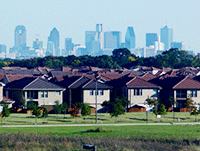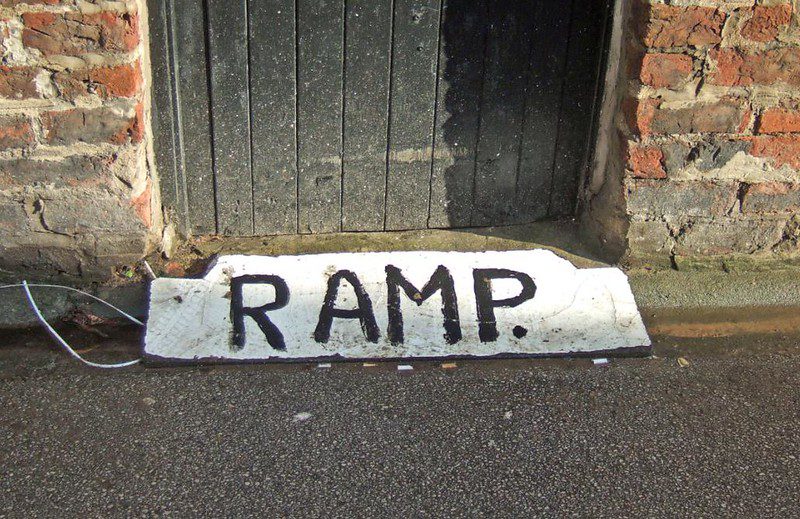
The U.S. Department of Housing and Urban Development (HUD) announced a new rule to change the formula determining how much rent a housing voucher will cover. Currently voucher holders, the great majority of whom are African-Americans and other people of color, are highly concentrated in low income, racially segregated neighborhoods—often the only areas where the value of a voucher meets the cost of rent, or where landlords are less likely to discriminate against people with vouchers. In these areas where HUD data shows “there is a wide variance in the rents being charged to tenants and where voucher holders are concentrated in a few high-poverty neighborhoods,” HUD would require local housing authorities to use Small Area Fair Market Rent (SAFMR) calculations to set different maximum allowable voucher rent levels by zip code.
Right now, most vouchers are pinned to an area’s Fair Market Rent, which HUD determines as the standard payment amount for each metropolitan area or county. By narrowing the scope of allowable rents to individual zip codes, SAFMRs allow for higher rents in more expensive areas and lower subsidies in less affluent areas.
To use Dallas as an example: With Fair Market Rent levels from 2015, the rule change would set a voucher subsidy for a one-bedroom apartment in the 75203 zip code south of downtown, one of the lowest-income areas in the city, at just $550 per month. But it would essentially double the monthly subsidy for a one-bedroom in the affluent 75225 zip code in North Dallas, at $1,090.
The proposed change now enters a 60-day public comment period and, if ultimately enacted, would dramatically improve housing options for voucher holders in 31 metropolitan regions, including three in Texas: Dallas-Plano-Irving, Fort Worth-Arlington and San Antonio-New Braunfels.
The current voucher program leaves its users, who are predominantly African-American and Hispanic, without much choice but to live in racially segregated, low opportunity neighborhoods. In the 11 largest cities in Texas, nine out of 10 voucher holders are non-white and nine in 10 live in a majority-minority Census tract, with seven in 10 living in a neighborhood defined by the federal government as a “poverty area.” Those areas almost always have lower performing schools, less access to good jobs, more crime, more environmental hazards and many more disadvantages than higher opportunity areas where voucher holders, until now, have mostly been kept out.
The official HUD statement on the proposed rule change notes that it is partially based on groundbreaking new research into the effects of place by Raj Chetty and others at Harvard’s Equality of Opportunity Project. Chetty’s team found that our outcomes in life are significantly influenced by the neighborhood in which we grow up, especially for low income children, and that moving from a low opportunity area to a high opportunity area can mean the difference in hundreds of thousands of dollars in future income. According to the HUD statement, “Findings from this new study, along with HUD’s own research, support the Department’s current policy direction of fostering opportunities for economic mobility.”
We at Texas Housers advocate for the four fair housing and neighborhood rights developed by our community partners at the Texas Organizing Project:
- The right to choose where to live.
- The right to stay in a neighborhood and not be displaced by gentrification.
- The right to equal treatment for all neighborhoods in terms of public infrastructure and services.
- The right to have a say in government action that impacts an individual and their neighborhood.
The right to choose where to live is the most critical component of fair housing laws. The concentration of housing vouchers in isolated, low opportunity areas perpetuates racial segregation and compounds the effects of poverty. The Inclusive Communities Project (ICP) in Dallas has been leading the way on this issue, helping more than 3,000 families move to a higher opportunity neighborhood since 2005 through their Mobility Assistance Program.
That program has only been possible because ICP sued HUD about the use of Fair Market Rents in the voucher program, successfully arguing that the program ran counter to fair housing by racially concentrating voucher holders. The suit resulted in a SAFMR demonstration program in the Dallas area, enabling thousands of ICP clients to move into areas that they otherwise would not have been able to afford.
Now, if the proposed rule chance is enacted, voucher holders in 30 more urban areas around the country will have the same chance. The program has worked in Dallas: Those moving with vouchers now live in areas with less poverty and far lower crime rates, even as voucher costs for the city have fallen due to a better balancing of rent levels. And the fears of those who predicted the demonstration program would drastically reduce the number of housing vouchers available have been shown to be unjustified.
Indeed, another benefit of SAFMRs is reduced waste in the voucher program—less taxpayer subsidy will go toward slum landlords in low income areas, who too often pocket the difference between their area’s actual market rent and the inflated Fair Market Rent of a voucher, without making any improvements to the housing conditions of their tenants.
We believe that this rule change will also combat the spread of gentrification. Traditionally low income, majority-minority communities undergoing rapid demographic shifts typically see precipitous increases in rent, leaving many residents, especially those with set voucher levels, unable to afford their housing. By adjusting each zip code’s voucher level to keep up with its SAFMR, HUD can ensure that voucher holders can continue to afford to live in gentrifying neighborhoods—which in itself slows the process of gentrification and preserves neighborhood diversity.
Research makes clear that the goals of fair housing—to give everyone the chance to live in a safe, decent and equitable neighborhood of their choosing—create inclusive communities and provide real, tangible, life-changing benefits.
This piece originally appeared on TexasHousers.net on June 17, 2016
(Photo credit: Courtesy of Texas Low Income Housing Information Service)






I would disagree with most of what Mr. Henneberger says. The other sides of SAFMR’s are:
Higher voucher payments will mean fewer households get vouchers — multiply this over 30 metro areas and a substantial decrease in households served will occur. This is not really a “fair” housing outcome.
Slumlords need to be made to fix their housing through the required inspections. Giving some voucher holders the opportunity to move to higher income areas will potentially result in disinvestment in areas that need more voucher holders to support higher rents, provide the required inspections that cause slumlords to fix their properties, and provide the income that creates the opportunity for revitalization.
The SAFMR rule would also make it more difficult to put project-based vouchers in minority areas. In our region, project-based vouchers create high quality new rental housing in areas that are ignored by the market. Without this tool opportunities for revitalizing areas will be lost.
In summary, the SAFMR idea seeks to make low-income areas even lower income, creating a self-fulfilling prophecy about those areas; and gives cities who are ignoring those areas now even more excuse to continue to ignore them. Cities should work with HCV programs to revitalize areas, not create more disinvestment.
Finally, the administrative burden of this rule will cost all housing agencies more. HUD’s rule should not be adopted and it will create self-fulfilling negative outcomes for current low income areas.
Andrew,
I haven’t done the research myself, but Matthew Desmond asserted in his book Evicted that overpayments actually dwarf underpayments and thus that SAFMRs would not only pay for themselves, but also could theoretically allow a massive expansion of the voucher program (which could also handle the some of the disinvestment question). (Note that John does assert that in Dallas the result of SAFMRs has been voucher costs falling.)
The effects could be quite different (including on all of the points you mention) if the net result is more vouchers or fewer. Certainly a massive out-migration of voucher holders from an area, all else being equal, would not be beneficial to those left behind. Whether that would happen is unclear.
I’m curious about others’ assessments or predictions.
Miriam
Miriam, while voucher costs may have fallen in the short run because the SAFMRs have dropped in impacted minority areas, costs will increase when and if tenants move to more expensive areas of opportunity.
I say if, because it is likely that many landlords in areas of opportunity will refuse to accept vouchers. This is a major problem where I live and won’t change until the Feds make it illegal to discriminate against voucher holders. Voucher holders may also choose not to move and leave their families, friends and support networks behind.
If voucher holders cannot move to areas of opportunity or choose not to move, then the goals for implementing the SAFMRs will have failed. In that case, their sole impact will be to reduce rental incomes in impacted areas. This will result in worse housing maintenance, lower property values and less investment in new housing projects.
Only time will tell what will happen and we will have to wait and see.
Jerry
The voucher program is a tenant-based subsidy program, and provides low-income families rental assistance, not a landlord subsidy program, or a community development program. Continuing to argue that vouchers should be used to prop up or overpay slum landlords, which is the way the program has historically worked in too many places, under the guise of “investment in low income communities,” ignores the significant resources that have been dedicated to that specific goal of revitalization, community development, investment in, etc. those communities.
The attention should be on understanding why those programs haven’t delivered the promised “revitalization” and what needs to be done to make them work, not continue to hold low-income families hostage in low-income, historically segregated, distressed neighborhoods. Fair Market Rents are supposed to be just that, and manipulating the process to overpay landlords in some areas, and underpay in others has had the demonstrable effect of making housing unavailable in predominately non-minority, better resourced areas to people because of race.
If the rents in predominately minority areas are depressed because of the conditions in those neighborhoods and those conditions are demonstrably the result of segregation and other forms of discrimination, as they often are, then the demand should be for a landlord subsidy that compensates them for providing good housing in those areas based on the fact that the “market” doesn’t work in such areas because of discrimination. Meanwhile, the voucher program should do what it is supposed to do — provide options and opportunities to low income families based on the real rental market.
There are very obvious ways to “protect” the right of a family to “stay” in a high-poverty area with their voucher, which can be accomplished without denying families the buying power of a voucher that is truly based on the reality of the rental market in which they wish to live. My concern is what landlords who have lived off the voucher program for decades will do to keep “their” tenants from moving (read Eva Rosen’s work on this), as well as the ongoing barrier of discrimination by members of the large apartment industry, so that is where our advocacy and attention will be focused as this rolls out.
Voucher holders should indeed have a choice of where to live. Although “moving to opportunity” can have benefits, living in housing improved through community development can also provide excellent results. We spend too much time arguing among ourselves instead of advocating to quadruple the budget for Section 8 Vouchers so that every eligible tenant can live in decent, safe housing. Housing assistance should be available for everyone who cannot afford market rate housing, ranging from the homeless, those who need supportive housing, to middle income residents who are being priced out of cities.